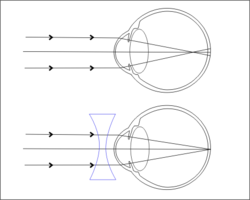Refractive errors of the eye
For correct vision, apart from the intact state of the retina and optic nerve pathways, it is a condition that the optical system is able to create a sharp image of the observed object on the retina, while it is necessary that the image of the point is again a point and that the image is formed on the retina. We refer to a normal eye as emmetropic. An eye (biophysics) that does not meet any of the above conditions is an ametropic eye.
Myopia (nearsightedness)[edit | edit source]
Nearsightedness, also known as myopia, is a condition where the short-sighted eye has a distant point, the punctum remotum, at a finite distance in front of the eye. Parallel rays entering the eye are refracted to a focal point in front of the retina. The main manifestation is poor visibility of distant objects.
Correction is done with glasses with a dispersion lens, which has a negative dioptric value.
There are two causes that lead to myopia:
- axial – the eyeball is too long (it is a congenital defect, it is explained by fluctuations in the dimensions of the eye arising during embryonic development);
- refractive - the eyeball has a normal length, but greater refraction of optical media. This cause of myopia is not so common.
Presbyopia occurs later in myopes and is not as pronounced because the loss of accommodation is partly compensated by the refractive error.
- Myopie
Hypermetropia (farsightedness)[edit | edit source]
Farsightedness (hypermetropia). The far point is at a finite distance behind the eye. Parallel rays entering the eye are refracted to the focus, which is behind the eyeball. This is because:
- the eyeball is too short (a more common defect, created during embryonic development);
- the eye has less refraction of the optical system than a healthy eye.
In farsightedness, presbyopia manifests itself much earlier. With decreasing accommodative ability, hypermetropia eventually needs distance glasses. A special case of hypermetropia is aphakia, which is a defect caused by removing the lens, for example for a cloudiness.
The defect is corrected with a coupling lens.
| - | Punctum remotum | Punctum proximum | Accommodation width | Correction |
|---|---|---|---|---|
| Emetropic - 20yo | 0D; in infinity | 10D; 10cm | 10 | No correction |
| Myopic - 20yo | 2D; 0,5m | 12D; 0,08m | 10 | -2D |
| Hypermetropic - 20yo | -2D; -0,5m | 8D; 0,125m | 10 | +2D |
| Emetropic - 40yo | 0D; in infinity | 4D; 0,25m | 4 | No correction |
Links[edit | edit source]
Related articles[edit | edit source]
References[edit | edit source]
- KYMPLOVÁ, Jaroslava. Katalog metod v biofyzice [online]. [cit. 2012-09-20]. <https://portal.lf1.cuni.cz/clanek-793-katalog-metod-v-biofyzice>.




